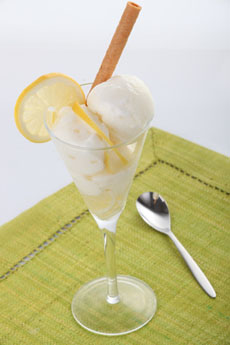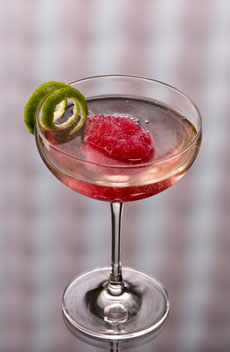Sorbet Dessert Cocktails & The Different Types Of Sparkling Wine
|
Drinking your dessert is especially delightful on a warm summer night. Make a “dessert cocktail” with different types of sparkling wine. The different types of sparkling wine are below. Start with a scoop of your favorite sorbet in a wine glass or stemmed dessert dish; top with sparkling wine and an optional garnish. You can have a higher proportion of wine to sorbet, as in the photo at right—a glass of sparkling wine with a scoop of sorbet. Or, take the other approach: A dish of sorbet with a sparkling wine pour-over, as in the photo below. Either way, you’ve got something light and luscious, with no more effort than scooping sorbet and pouring Champagne. That’s a win-win in our book. Beyond the simplicity of sparkling wine and sorbet, you can add a scoop of sorbet to a conventional cocktail: |
|
|
|
Seek inspiration by looking at the flavors of sorbet in your market. Don’t be scared off by exotic flavors. One of our favorite creations is a French 77 (Champagne and St. Germain Elderflower Liqueur) with lychee sorbet that we found in an Asian market. (Elderflower tastes a lot like lychee.) And then, there’s the ice cream cocktail. Two of our favorites: |
||
 [2] Lemon sorbet with a Prosecco pour-over. |
THE DIFFERENT TYPES OF SPARKLING WINE Asti or Asti Spumante, from the Asti region of Italy, is a sweeter style of sparkler made from Muscat grapes. The sweetness is perfect for dessert pairings, and the lighter body and low alcohol content (about 8%) help. Cava, from Spain, is available in white or pink. As with Champagne, it is made in different levels of dryness/sweetness. Champagne, the world’s most famous and costliest sparkler, is produced in the Champagne region of France. Although even the least expensive bottles are pricey, you can find something in the $25 range. Unless you’re a rock star, don’t pour Dom Perignon into a sorbet cocktail: The sweet sorbet will overwhelm the complexity and finesse of a great Champagne. Cremant, from France, is a sparkler that can be produced in any region. It has lower effervescence than Champagne, giving it a creamy mouth feel. |
|
|
Espumante, or Vinho Espumante, from Portugal, is made in a process similar to Champagne. Look for either VEQPRD (Vinho Espumante de Qualidade Produzido em Região Determinada) or VFQPRD (Vinho Frisante de Qualidade Produzido em Regiao Determinada). The difference is that E stands for espumante, sparkling, and F stands for frisante (semi-sparkling). Prosecco, from the Veneto and Friuli Venezia Giulia regions of northern Italy, is a lighter-bodied sparkler, most often drunk as an apéritif. But serve it with warm-weather fare instead of a still white wine. Sekt, from Germany. The top-quality Sekts are a great experience, with delicate biscuit and brioche accents.Here’s more about Sekt. There are also sparkling white wines from Austria, England, New Zealand, South Africa, the U.S., and other countries. Not to mention the red wine sparklers, such as Italian Brachetto and Lambrusco, and Australia’s sparkling Shiraz. When you’ve created your signature sorbet cocktail, please share the recipe with us! CHECK OUT WHAT’S HAPPENING ON OUR HOME PAGE, THENIBBLE.COM. |
||



